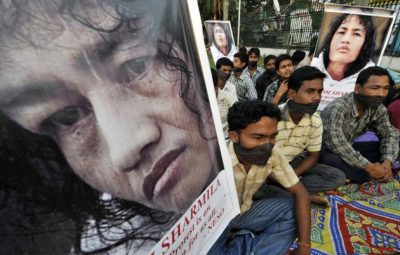By
Ananya S Guha
The fifteen year fast by Irom Sharmila in Manipur is largely going unnoticed, excepting some media attention sporadically and the routine newspaper reports.
But, that may not be the point. The point rivets to a larger question, the question of North East India, some part of it or the other involved for over four decades in a spate of turmoil or unrest – call it separatism, militancy, extremism or terrorism. This large question epitomizes the entire dilemma of this part of the country – alienation from the ‘mainstream’, an expression glibly but disputatiously used. What is this ‘mainstream’ or ‘mainland’, as if others are peripheral to them, and only they enjoy the large slice of our endearing ‘Bharat Mata’!
I am certainly not a social scientist, let alone a socialist; What I have observed since my college and university days is a deep seated alienation, an insecurity of being rejected, a desire to be known by the rest of the country manifested by expressions such as Naga and Mizo insurgency, the Assam Agitation, the Tripura unrest against the majority, etc.
All these may have taken the shape of violent separatism, or secessionist tendencies, most of them at least; but the point missed is the causal forces behind them, the – ‘why.’ Social Scientists in the 1980s played havoc with ideas positing geographical, international boundaries and citing them as strategic locations for a region waiting to be exploited by foreign elements. As if geographical borders did not exist earlier and as if there was no East Pakistan, an undivided Bengal and Assam existing under a large province! Of course in its wake Independence for the country brought further interrogation – the Naga question, the Mizoram trauma as a result of the famine, and the Manipur question of accession. Tripura and Assam came much later, both related to the question of influx, ‘foreign nationals’ and the outsider/insider debate, an uneasy co-existence. Further in Assam came the Bodoland consideration and now in Meghalaya, Garoland.
By and large the government used the carrot and stick policy, and in some spaces – Accord and Ceasefire. Whether these have worked or not or worked only as temporary measures will have to be examined. But the larger questions of local identity as opposed to a Pan Indian identity, unemployment and fear of jobs being snatched by ‘outsiders’ were and still are issues which are not addressed. In other words, the mindset of a people pitted against what they feel is at times a repression, I think dominates the psyche. The feeling is common to all the states, and in marking out a region nebulously called “The North East” governments have actually contributed however unwittingly to feelings of separatism, alienation and rejection. Added to this were those incidents involving students of North East India in New Delhi especially.
Having woven a matrix for a region earmarked as a separate entity, despite diversities in language and religion, has in itself invited problems for all governments, though they may not be willing to share this responsibility.
The Irom Sharmila example is woven around that symbol, that tapestry of resistance to, not a country, but a Government which refuses to push ahead with soluble ideas and is blighted to the condition of men, women and children living in trauma, year after year with men in uniforms whom they cannot resist nor desist because there is also the dire threat of other extremist groups. Living in conflict zones and their ramifications on mobility, employment and education, have to be captured imaginatively by ruling powers.
Irom Sharmila is a tower of protest, but she is also a tower of neglected suffering, where aspects like forced feeding, release and bail are cyclical epitomes of crass neglect and – passivity.
As such, until all this seething continues the North East will remain a symbol of solidarity and empathy with one another, which means of course alienation from the ‘mainland’, which in turn means that that the ‘mainland’ and ‘hinterland’ conflict will continue as a festering wound.



No Comments Yet!
You can be first to comment this post!